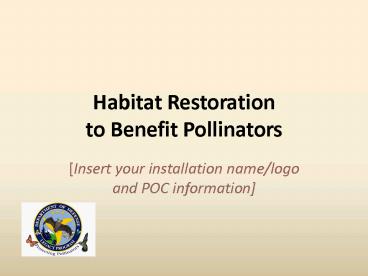Habitat Restoration to Benefit Pollinators - PowerPoint PPT Presentation
1 / 11
Title:
Habitat Restoration to Benefit Pollinators
Description:
What is the impact to the mission? What is it going to cost me to protect pollinators? Where is ... Lady Bird Johnson Wildflower Center (www.wildflower.org) ... – PowerPoint PPT presentation
Number of Views:93
Avg rating:3.0/5.0
Title: Habitat Restoration to Benefit Pollinators
1
Habitat Restorationto Benefit Pollinators
- Insert your installation name/logo and POC
information
2
Pollinators on Military Lands
- Questions you are likely to hear
- What is the problem?
- Why should I care?
- What is the impact to the mission?
- What is it going to cost me to protect
pollinators? - Where is this going to happen on
base/post/station? - Who really benefits from protecting pollinators /
providing habitat for pollinators?
3
Pollinators are in trouble!
- Why should I care?
- Fewer Pollinators
- ?
- Less pollination of flowers
- ?
- REDUCED production of fruits and vegetables
- FAILURE of native plant communities and habitat
restoration projects - LIMITED survival of endangered plants and
animals.
Plant pollination by insects is essential to
human health, global food webs, and protection of
biodiversity. Pollination is a globally important
ecosystem service.
4
Land management benefits pollinators
- There should be no change or minimal change to
current land management techniques - Prescribed Fire
- Pesticide Treatments
- Grazing
- Mowing
- Mission Demands
- Native Habitats / Refugia
5
Land management benefits pollinatorsat
installation name
- Include information on three or four current land
management practices at your installation that
benefit pollinators, or insert specific
information into previous slide.
6
Creating habitat for pollinators
Urban Gardens can provide both nectar plants and
rearing areas.
- Plant Native species that have varying bloom
periods. - Provide access to water and nesting sites.
- Control or Remove Invasive species
- Limit use of pesticides/ chemicals
7
How can installations provide habitat for
pollinators?
- Incorporate pollinators into INRMPs
- Maintain bare soil areas away from main base
- Monitor for pollinator species
- Create corridors between pollinator habitats and
minimize fragmentation. - EDUCATE base and housing personnel
Combining nesting sites with foraging areas
creates good native bee habitat.
8
Pollinator Habitat Restorationat installation
name
- Insert specific suggestions and needs for your
Commander here - Include the resources that will be required and
specific actions needed by the Commander
9
Benefits to the Mission
- How will the implementation of your suggestions
benefit your installations mission?
10
For more information on pollinators
- North American Pollinator Protection Campaign
(www.nappc.org) - Pollinator Partnership (www.pollinator.org)
- Xerces Society for Invertebrate Conservation
(www.xerces.org) - U.S. Forest Service Celebrating Wildflowers
(www.fs.fed.us/wildflowers/pollinators/index.shtml
) - U.S. Fish Wildlife Service (www.fws.gov/Pollinat
ors) - United States Department of Agriculture
(www.ars.usda.gov/main/site_main.htm?modecode5428
0500) - USDA National Agroforestry Center
(www.unl.edu/nac/agroforestrynotes.htm) - National Biological Information Infrastructure
Pollinators (pollinators.nbii.gov/portal/server.pt
) - National Wildlife Federation Create a Certified
Wildlife Habitat (www.nwf.org/backyard) - Wildlife Habitat Council (www.wildlifehc.org/polli
natorpractices/index.cfm) - The Green Book Environmental Guidebook for
Military Golf Courses (www.denix.osd.mil/portal/pa
ge/portal/denix/environment/NR/conservation/Planni
ngToolsHandbooksGuidelines/TheGreenBook) - Pollinator Conservation Digital Library
(pollinatorlibrary.org) - Michigan State University Enhancing Beneficial
Insects with Native Plants (nativeplants.msu.edu) - Urban Bee Gardens (nature.berkeley.edu/urbanbeegar
dens/index.html) - Lady Bird Johnson Wildflower Center
(www.wildflower.org) - Local Botanical gardens, Native Plant Societies,
garden clubs
11
Thank you. Questions?
- Insert your contact information here.































